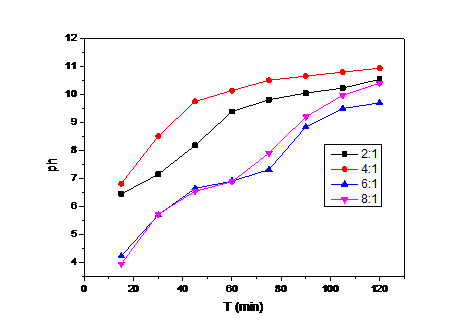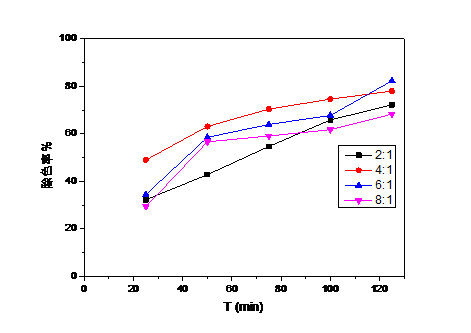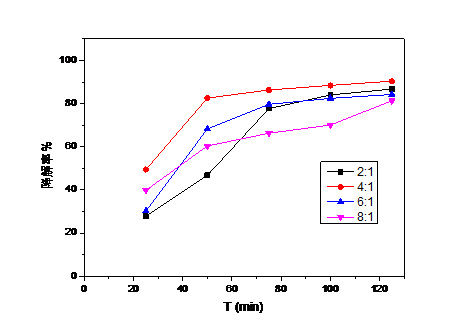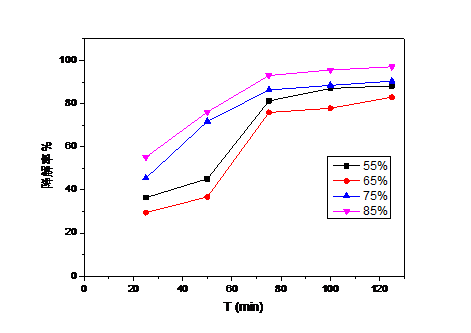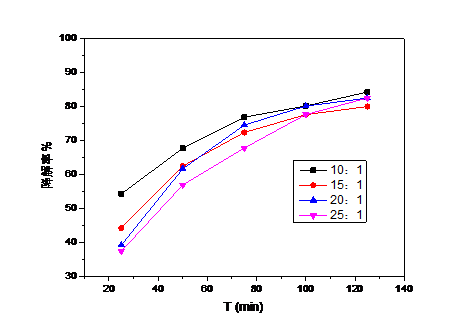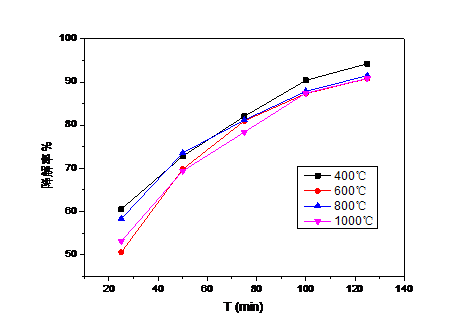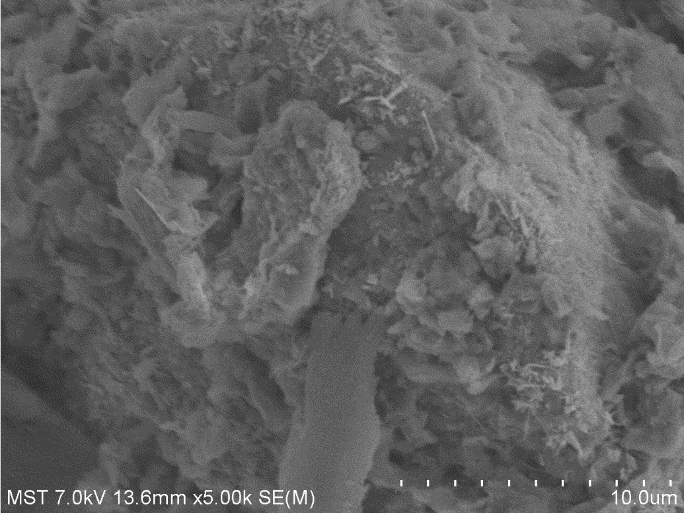铁碳微电解填料的制备及表征毕业论文
2020-07-04 19:48:26
摘 要
本论文根据相关课题前人经验,采用高温焙烧法制得铁碳微电解填料。将铁(Fe)、碳(C)以一定质量比混合后,加入膨润土和草酸铵((NH4)2C2O4),造粒成型之后放入高温管式炉进行焙烧。在制备阶段,从四个角度来优化填料性能:1.改变铁碳质量比,实验得最佳铁碳质量比为4:1;2.改变铁碳总含量,实验得最佳铁碳总含量为75%;3.加入铜粉,改变铜铁质量比,加入铜粉的目的是增加电极电位差,从而提升填料的处理效果,加入铜粉后为三元填料,实验得最佳铁铜质量比为10:1 ;4.改变焙烧温度,实验得最佳焙烧温度为800℃。
制得的填料进行表征实验,得到填料表面的扫描电子显微镜图(SEM)和填料剖面的扫描电子显微镜图(SEM)。由图看出,大而密集的孔隙分布在填料表面,孔隙率大可以使填料与被治理废水的大面积接触,利于渗入混合,进一步使微电解反应有更高的效率。本实验最终确定的最佳合成条件为:Fe:C=4:1、铁碳总含量=75%、Fe:Cu=10:1、焙烧温度=800℃。在此条件下对100mg/L的甲基橙溶液降解125分钟后,降解率达到91.47%。
铁碳微电解法在治理印染废水行业有很大的应用且前景良好,铁碳微电解填料的不断优化也是深入研究的主要方向。
关键词:铁碳微电解 三元填料
Preparation and Characterization of Iron Carbon Micro-electrolysis Filler
Abstract
Based on previous experience of related topics, we use high-temperature Roasting Method to Produce Iron-carbon Micro-electrolytic Filler. After mixing iron and carbon at a certain mass ratio, we added Bentonite and ammonium oxalate . Then put into high-temperature tube furnace for roasting after granulation molding. In the preparation stage, the optimization of synthesis conditions for iron-carbon micro-electrolytic fillers is mainly performed from four aspects:1. Iron-carbon mass ratio, final determination of the best iron-carbon mass ratio of 4:1; 2. The total iron carbon content, and ultimately determine the best total iron and carbon content of 75% ; 3. The effect of the copper-iron mass ratio on the filler treatment effect is that the purpose of adding the copper powder is to increase the potential difference of the electrode, and finally the best mass ratio of copper to iron is 1:10.4. Roasting temperature, ultimately determining the optimum roasting temperature of 800°C.
The prepared fillers were subjected to characterization experiments to obtain scanning electron micrographs (SEM) of the filler surface and scanning electron microscope images (SEM) of the filler profiles. It can be seen from the figure that the surface structure of the filler is loose and porous, and the large porosity is very favorable for the full contact and mixing of the filler and the wastewater, thereby improving the efficiency of the microelectrolysis reaction. Under these conditions, the degradation rate of methyl orange solution of 100mg/L reached 91.07% after 125 minutes of degradation.
The iron-carbon micro-electrolysis method has good application prospects in printing and dyeing wastewater and other industries. Continuous optimization of iron-carbon micro-electrolytic fillers is also the main direction of in-depth research.
Key words: Iron carbon microelectrolysis; Ternary packing
目录
摘要 I
Abstract II
第一章 文献综述 1
1.1课题背景 1
1.2铁碳微电解法简介 2
1.2.1铁碳微电解法 2
1.2.2铁碳微电解法的反应原理 2
1.2.3微电解填料的分类 4
1.2.4铁碳微电解法治理废水的影响因素 5
1.3 研究内容 6
第二章 实验 7
2.1 实验试剂及仪器 7
2.1.1 实验试剂 7
2.1.2 实验仪器 7
2.2 铁碳微电解填料的制备 7
2.2 模拟废水的制备 10
2.3 性能(对废水处理效果)实验 10
2.4 表征手段 13
第三章 实验结果及讨论 14
3.1不同铁碳质量比对填料处理效果的影响 14
3.1.1 不同铁碳比对PH的影响 14
3.1.2不同铁碳比对色度的影响 15
3.1.3 不同铁碳比对降解率的影响 15
3.2 不同铁碳总含量对填料处理效果的影响 16
3.3 不同铜铁质量比对填料处理效果的影响 17
3.4 不同焙烧温度对填料处理效果的影响 18
3.5 铁碳微电解填料表征 19
第四章 结论 21
参考文献 22
致谢 24
第一章 文献综述
1.1课题背景
人体的70%的组成成分都是水,水是生命的基础,同样也是经济发展的基石,水对于人类十分重要。在中国人口中,有82%使用的是浅井和江河水,而在这些水源中有75%被污染,甚至污染超标,近1.6亿人口饮用受过污染的水。经济不断发展,人口也日益增长,水资源污染也愈发严重,成为我国工业进一步发展的限制因素,绿色化工应运而生。
污染水中难治理的代表之一就是印染废水,其污染量一直在我国工业部门的排名居高不下,全国工业部门的污染水的11%来源于印染废水,排放量大约21亿吨每年,而COD排出量也占比9%左右,一年约排放30亿吨。印染废水占纺织业废水70%以上,是我国水资源污染大户,印染废水的排放量在全国工业部门仅次于第一位,排放废水中的污染物质,总的数量排在全国工业部门的第四位。而印染废水数量庞大、水质变化多、有机物污染含量高、成分复杂、可生化性低等特点造成了其难处理、治理成本高昂。
现阶段,我国主要采用三大类方法来治理废水:物理法、化学法和生物法。
相关图片展示:
